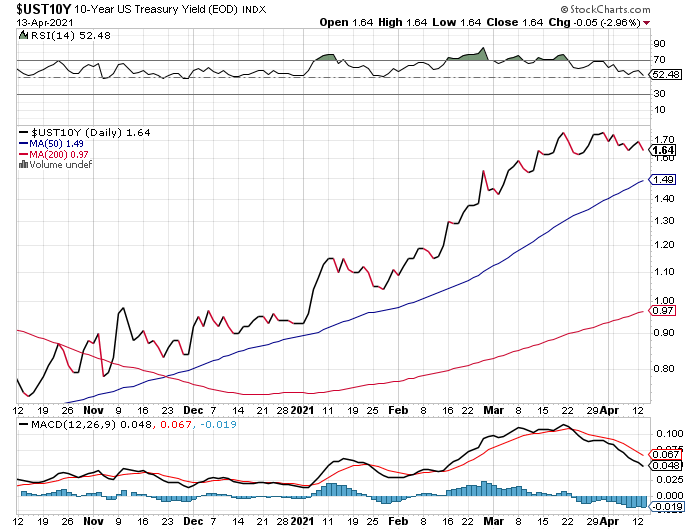Headline inflation rose sharply in March. The bond market yawned.
It’s still early for deciding if last month’s acceleration in the Consumer Price Index (CPI) is an early warning of things to come or a temporary detour in the long-running disinflationary trend. The Treasury market’s initial reaction, however, was hard to misread.
CPI at the headline level rose 2.6% on a year-over-year basis through March, the US Bureau of Labor Statistics reports. That’s a sharply faster pace over February’s 1.7% increase.

The bond market hardly seemed to notice. The benchmark 10-year Treasury yield slipped on Tuesday (Apr. 13), edging down to 1.64%, close to a one-month low. Why the muted response?

Perhaps because core CPI, which is a more reliable measure of the trend, posted a modest bump-up in its one-year change: 1.6% in March vs. 1.3% in February. Inflation picked up, but the core reading suggests that the underlying trend still reflects subdued pricing pressure. Indeed, a 1.6% core CPI rise still ranks well below the pre-pandemic 2%-plus pace and is also under the Fed’s 2% inflation target. In short, nothing much changed last month by this reading.
Learn To Use R For Portfolio Analysis
Quantitative Investment Portfolio Analytics In R:
An Introduction To R For Modeling Portfolio Risk and Return
By James Picerno
Some fixed-income managers are still waiting for convincing evidence of a material shift in the inflation outlook. “I’ve been managing bond portfolios for 25 years, through very large monetary programs, big deficits, and the Fed trying to raise inflation expectations,” says Janus Henderson’s Greg Wilensky. “As much as I can see legitimate reasons why it might happen this time — I could have said that very often over the last 12 years too.”
One reason for remaining skeptical that inflation’s set to run persistently hotter: the jump in headline CPI in March is largely due to two fleeting factors – so-called base effects. First, the year-over-year comparison is temporarily inflated by the brief bout of inflation last spring during the initial shock of the coronavirus. In turn, energy prices (oil in particular) collapsed. As those events wash out of the data, the inflation trend will stabilize — unless other factors intervene.
That leads to the big question: are other forces at work beyond base effects that will lift inflation higher and keep it elevated? A popular narrative is that ramped-up and ongoing monetary stimulus, now joined by a surge in fiscal spending, will ignite pricing pressure.
One bond shop that remains unconvinced is Hoisington Investment Management, which for years has (correctly) positioned its portfolios for ongoing disinflation/deflation. Is there a reason for an attitude adjustment? No, according to the firm’s latest quarterly outlook.
“Contrary to the conventional wisdom, disinflation is more likely than accelerating inflation,” the money manager advises. “The inflationary psychosis that has gripped the bond market will fade away in the face of such persistent disinflation.”
Among the various reasons cited by Hoisington for its continued forecast of disinflation/deflation: weak bank lending, high levels of debt in the economy, and the ongoing decline in the velocity of money, a measure of how quickly money changes hands.
The pushback to this analysis is that the money supply has exploded in recent years under the Federal Reserve’s guidance. True, but that alone isn’t a trigger of higher inflation, Hoisington explains. “When money increases and velocity falls, the money is trapped in the financial markets and has only a minimally lasting impact on the real economy.”
As example, Hoisington points to the falling loan-to-deposit ratio for banks, which signals continue disinflationary pressure. “This ratio has just slumped to a new low for the history of the series that starts in 1973. The chairman of the largest US depository institution recently said that he could not make a profit from lending their deposits.”

Nonetheless, the inflationistas see the seeds of higher inflation starting to sprout and are poring over incoming data in search of support. Yesterday’s CPI report, however, was a wet rag in the cause of convincing markets that a new era of inflation is upon us.
How is recession risk evolving? Monitor the outlook with a subscription to:
The US Business Cycle Risk Report
Pingback: Headline Inflation Rose Sharply in March - TradingGods.net